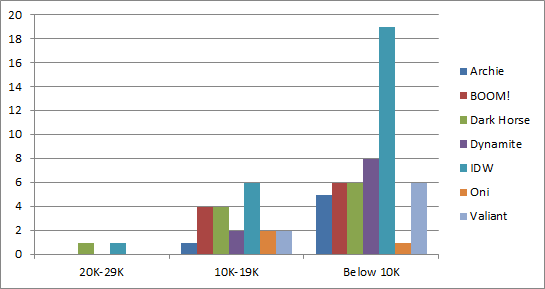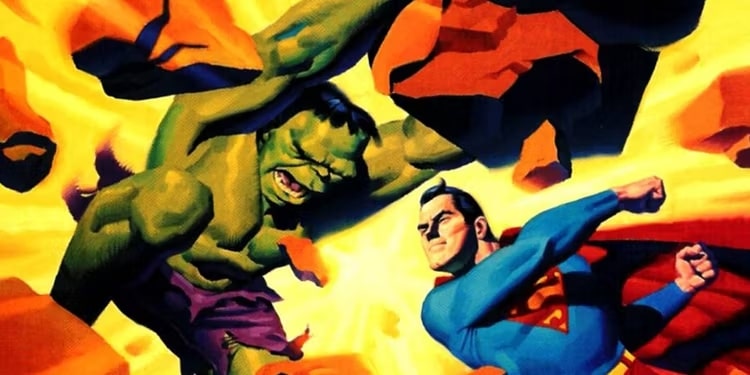Continuing where we left off yesterday, next on the list are the May Sales of Image and the other Independent publishers.
Standard disclaimers: The numbers are based on the Diamond sales charts as estimated by the very reliable John Jackson Miller. These charts are pretty accurate for U.S. Direct Market sales with the following caveats: 1) you can add ~10% for UK sales, which are not reflected in these charts; 2) everyone’s best guess is you can add ~10% for digital sale – while some titles do sell significantly better in digital (*cough* Ms. Marvel *cough*), that’s the average rule of thumb; 3) it’s not going to include reorders from subsequent months, although reorders will show up in subsequent months if they’re high enough. So if you’re a monster seller in Southampton and the it took the US audience 3 weeks to reorder, it’s probably not going to be reflected here.
What’s a sales band? Its another way to have a higher level view of the market. The general idea is to divide the market into bands of 10K copies sold and see how many issues are in each band. How many issues sold between 90-99K copies, 80-89K copies, etc. etc. In very broad terms, the market is healthier when there are several titles selling in the 70K-100K+ range because titles that move a lot of copies give the retailers some margin of error on their ordering. When you see titles selling in the 20-29K band and especially below, there’s a pretty good chance a lot of retailers aren’t ordering those titles for the shelf (pull box/pre-order only) or minimal shelf copies at best.
For the purposes of these sales band charts, we really are looking for titles that are selling 10K and over, so only publishers with an issue that topped 10K will be listed here. There are also going to be plenty of titles/issues that didn’t make the chart, which generally means they sold under ~5200 in May, but some lower selling titles are reported and that’s not a hard and fast rule. The sad fact is, most independent comics sell under 10K and it’s when they cross that line that they really start getting noticed.
Image really has to be its own chart. It exists in a space between DC & Marvel’s realm and the rest of the independents.
Did you hear some laughter in the distance? That’s Robert Kirkman. He knows what I’m about to type.
You see that blue mark in the 70-79K band? That’s Walking Dead. At 74K, Walking Dead is the #2 bestselling ongoing title. Batman is #1 with 96.5K for the non-event tie-in issue that came out in May. Marvel’s bestselling non-#1/multiple variant cover/stunt ongoing was Star Wars at just under 71K. So Walking Dead is outselling every Marvel “regular” ongoing title. I think this falls under “dare to dream.”
Image’s charts vary widely, depending on which titles are on a break while the trade paperbacks are coming out. For instance, May had no issue of Saga, which would be up there pretty high. It does, however, have an issue of the red hot Seven to Eternity clocking in at just over 30K. And remember, anything in the 20K-29K band is something that would be considered a reasonable, if not solid, seller at today’s DC or Marvel. Especially Marvel.
With the rest of the Independents, Dark Horse tops out at just under 27K for Neil Gaiman’s American Gods Shadows. IDW has Batman / Teenage Mutant Ninja Turtles at 23.2K. That’s the tops of the rest of the independent scene.
As usual, IDW shows the most volume and gets the most entries in the 10K-19K band. It’s largely licensed books that sell 10K+ outside of Image. Interesting notes include a 10.1K debut for the $1 priced debut of Damned at Oni; 3 issues in, the relaunched X-O Manowar is still at 16K for Valiant; Dark Horse’s Black Hammer is the bestselling non-Image creator owned title at 11.6K (depending on how you view the rights situation for TMNT).
Want to learn more about how comics publishing and digital comics work? Try Todd’s book, Economics of Digital Comics or have a look at his horror detective series on Patreon.










The charts are a great way to visualize performance of the bigger indie publishers. They all have strengths in the under 20k range. All it would take to push those sales figures up into competing with DC and Marvel would be a partnership with a deep pocket company with better market penetration. Like a Google or Amazon, or media or shopping conglomerate. I wonder if they are talking about that strategy right now?
Plenty of smaller publishers already have their comics on comiXology Unlimited/Kindle Unlimited where I believe they get paid per page view and/or a fixed amount for licensing. Marvel has recently followed suit but of course, they were way ahead of the game with Marvel Unlimited.
Dunno what effect subscription services have for periodicals sales in comic shops, though. Don’t really see big corp being interested in single issue print comics. Not enough profit given the hassle of handling it.
Comments are closed.